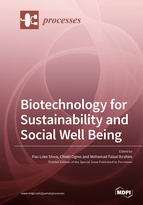Biotechnology for Sustainability and Social Well Being
A special issue of Processes (ISSN 2227-9717). This special issue belongs to the section "Biological Processes and Systems".
Deadline for manuscript submissions: closed (31 December 2020) | Viewed by 73682
Special Issue Editors
Interests: biotechnology; bioprocess; bioengineering
Special Issues, Collections and Topics in MDPI journals
Interests: biorefinery; engineering; biotechnology; bioengineering; metabolic engineering
Special Issues, Collections and Topics in MDPI journals
Interests: waste utilization for value-added products through biotechnological approaches
Special Issues, Collections and Topics in MDPI journals
Special Issue Information
Dear Colleagues,
Bioprocessing is a very important technology that utilizes living organisms and their components to produce various types of products. The products and services that depend on bioprocessing can be grouped into the following: (1) Biopharmaceuticals that involve in the production of therapeutic compounds, vaccines, and diagnostic components. (2) Specific bio-based chemicals such as biofuels, food, and agricultural products; fine chemicals derived from and/or by living organisms; and other types of bioproducts. (3) Environmental management aids that use bioprocessing to treat, control, or remediate pollutants and toxic components. Bioprocessing is one of the key factors in several emerging industries of biofuels, used in the production of biogas, bioethanol, and biodiesel; industrial enzymes; waste management through biotechnology; new vaccines; and many more. Bioprocessing is always referred to as the technology that produces products and provides services that are environmentally friendly, sustainable, and renewable.
The important role of bioprocessing has attrackted interest from researchers to find suitable bioprocess to enhance the production or process efficiency. Asian Federation of Biotechnology (AFOB) has set 12 academic divisions that cover all biotechnological areas. Most of these areas require bioprocess technology for the production of their desired products. To share the recent technologies and findings in biotechnology, AFOB Malaysia Chapter (AFOB-MC) is organising the Second AFOB Malaysia Chapter International Symposium 2019 (AFOBMCIS 2019), to be held in Putrajaya, Malaysia, on 20–23 October 2019. The theme of the symposium is “Biotechnology for Sustainability and Social Well Being”, which covers 12 technical sessions, namely: (1) agricultural and food biotechnology; (2) applied microbiology; (3) biopharmaceutical and medical biotechnology; (4) biocatalysis and protein engineering; (5) bioprocess and bioseparation engineering; (6) bioenergy and biorefinery; (7) environmental biotechnology; (8) marine biotechnology; (9) nanobiotechnology, biosensors, and biochips; (10) systems and synthetic biotechnology; (11) tissue engineering and biomaterials; and (12) bioindustry promotion and bioeducation. All of the authors of the accepted contributions at AFOBMCIS 2019 related to bioprocessing are invited to submit manuscripts to Processes under the Special Issue of Bioprocessing.
Dr. Pau-Loke SHOW
Prof Dr. Chiaki Ogino
Dr. Mohamad Faizal Ibrahim
Guest Editors
Manuscript Submission Information
Manuscripts should be submitted online at www.mdpi.com by registering and logging in to this website. Once you are registered, click here to go to the submission form. Manuscripts can be submitted until the deadline. All submissions that pass pre-check are peer-reviewed. Accepted papers will be published continuously in the journal (as soon as accepted) and will be listed together on the special issue website. Research articles, review articles as well as short communications are invited. For planned papers, a title and short abstract (about 100 words) can be sent to the Editorial Office for announcement on this website.
Submitted manuscripts should not have been published previously, nor be under consideration for publication elsewhere (except conference proceedings papers). All manuscripts are thoroughly refereed through a single-blind peer-review process. A guide for authors and other relevant information for submission of manuscripts is available on the Instructions for Authors page. Processes is an international peer-reviewed open access monthly journal published by MDPI.
Please visit the Instructions for Authors page before submitting a manuscript. The Article Processing Charge (APC) for publication in this open access journal is 2400 CHF (Swiss Francs). Submitted papers should be well formatted and use good English. Authors may use MDPI's English editing service prior to publication or during author revisions.
Keywords
- bioprocess
- bioproducts
- bio-based chemicals
- biomaterials
- fermentation








